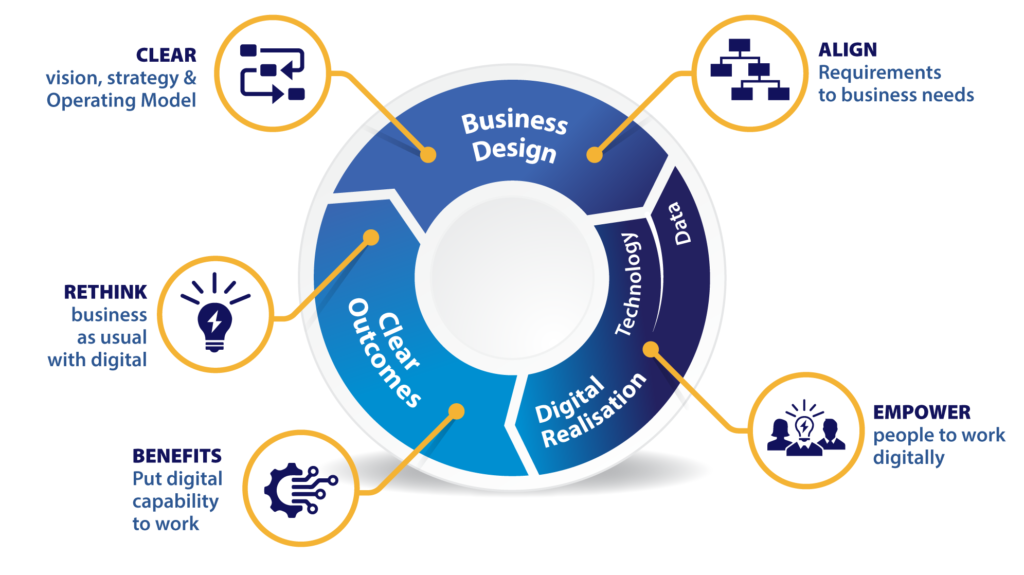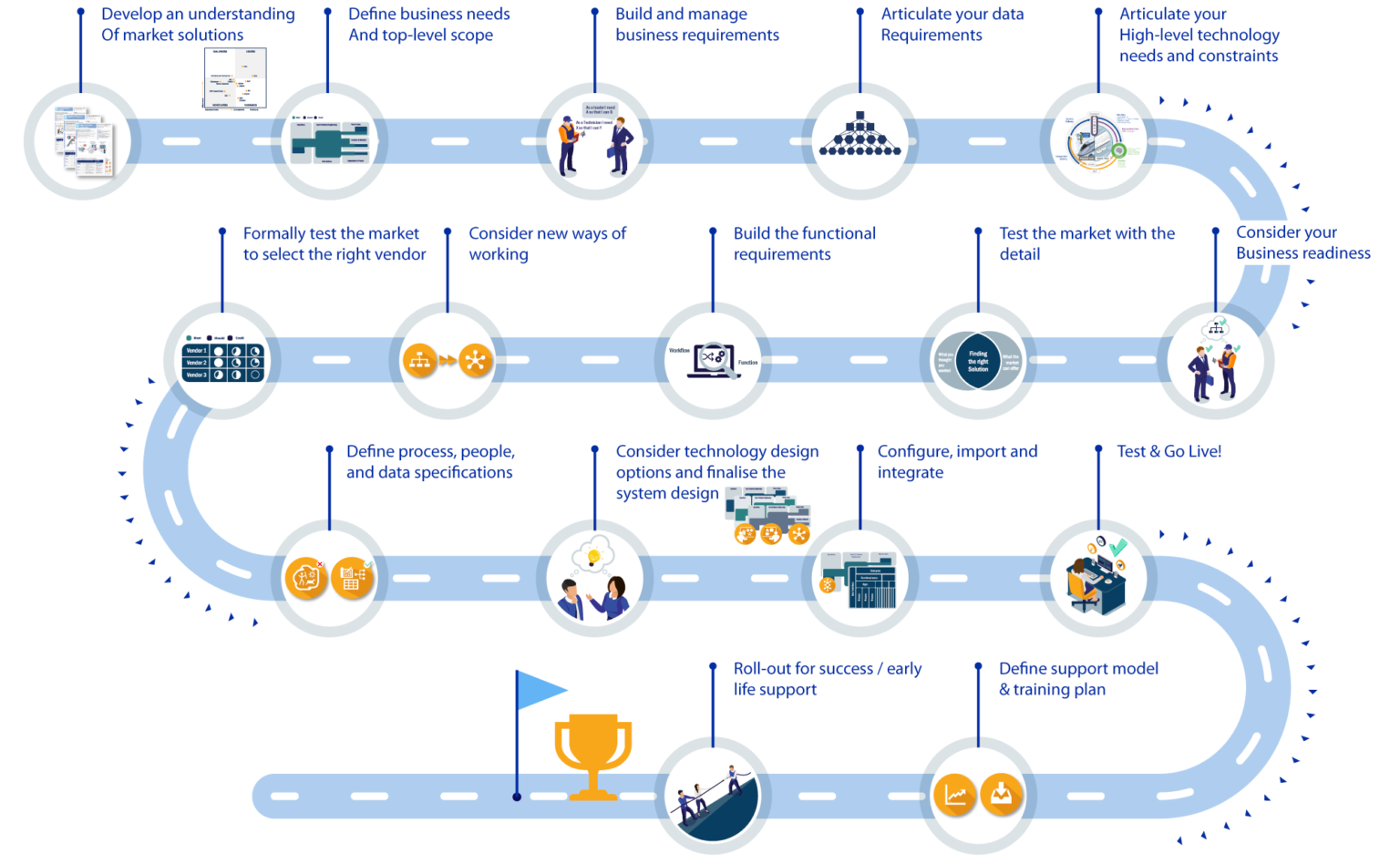WHO IS
DRIVING YOUR
TECHNOLOGY
CHANGE?
THE BUSINESS OR THE SOLUTION?
10th December 2021


HELLO WORLD
This paper was developed to help organisations look at how they might invest in technology to transition or transform the way they deliver services. We have scoured material from across industry and woven in our understanding and experience to give you a ‘cheat sheet’ to navigate the digital hype with equal parts excitement and realism to form a better understanding of what it takes to deliver digital transformation for infrastructure management organisations.
Are you trying to answer one of the following questions:
We recognise that every organisation is different and is at a different stage in their journey, but we’ve noticed a lot of similarities including the same challenges faced in the pathway for digital adoption.
Unfortunately, the data speaks for itself (see Part 2) and many of us are falling into the trap of seeing technology as a shortcut, failing to see that; until humans aren’t the ones making decisions, technology change is fundamentally about people. This means influencing an organisation’s culture, values, and behaviours and this does not have a quick fix. Anyone who’s been through this will tell you, delivering people change takes time and effort but for some reason, time and time again, we’re expecting transformation to happen within the span of a single technology project.
At AMCL, we believe that data and technology must always maintain line of sight to business needs and clear outcomes. We believe that all organisations are somewhere on ‘The Wheel’ below between understanding what they’re looking to achieve (outcomes), pulling together a design that meets the business needs, or perhaps neck-deep in implementing your design.
Whether you’re on your ‘first turn’ in adopting a part of digital for the first time; or have been circumnavigated the wheel and are constantly re-examining how digital capability can redefine the way you work; in reading this paper; we hope you will find context, perspective, awareness, and top tips for the next step in your journey.
After reading this paper, we hope to leave you with an understanding of what technology and data is for Infrastructure Asset Owners and Operators as well as the scale of the challenge, you will gain some practical perspective on the potential benefits as well as the hype, and have a glimpse at a tried and tested, practical methodology, to approach digital capability adoption.

...let’s get into the detail!
01

WHAT IS ‘DIGITAL’
CAPABILITY?
‘Digital’ is on everyone’s lips, the world of technology and data is doing things we couldn’t even imagine 10 years ago. The possibilities are seemingly infinite, and we can’t ignore that we live in an age where technology superpowers are widely available and highly economical. Industry peer pressure, increasing regulatory and economic stress are all driving toward a trillion-dollar industry across the world but why is the average Infrastructure Management Organisation so far behind leading edge?
There are many reasons why digital transformation efforts fail to realise their business case which we will explore in Part 2 but to begin, we need to define digital capability to set the scene for the rest of this thinking.
You might have heard of the journey from digitise through digitalise to digital transformation. The idea being to take an organisation from turning paper into digital data; through to a data and technology system of systems that fundamentally challenges your business model . Whatever happened to good old software and hardware?

Without getting into the nuances and for the purposes of a (relatively) accessible definition, we define digital capability as the data and technology which contributes to the definition and delivery of the operating model and the business capabilities which sit beneath it. Essentially the data and technology component of ‘everything that an organization is and can do.
To break digital capability into data and technology for infrastructure asset management businesses looks something like the below:
Digital data that, with the right context and integration, enables creation of information that supports decision making. This data is housed within technologies across the business and often supported by some form of an Information Management System.
Technology as the layers of software and hardware between an asset and the people responsible and accountable for service delivery. This includes all relevant ‘Information Technology (IT)’ and ‘Operational Technology (OT)’ as well as data science tools.

Have we lost you yet? Surely it doesn’t have to be this complicated.
Well, think of your mobile phone – one of the modern wonders that has radically changed almost everyone’s day to day life. Though its use is relatively simple it could take a lifetime to understand every layer of the software, hardware, and data that comes together to make it work. You can understand why, for decades, leaders around the world have been enticed by the potential of digital capability to deliver benefit to their organisation. Across industry, we need to be thinking about how the next generation of digital transformation efforts can learn from the last 10 years and put their best foot forward on a practical path to realising the benefits from data and technology.

If it was easy, everyone would be doing it

02
Is it possible to get it right, first time?
Hindsight doesn’t often capture the detail of the challenges and steps of the journey and it takes to deliver success in technology and data. While there are many case studies selling the great potential of unlocking benefits from data and technology, getting people to talk openly and honestly about failed digital transformation projects isn’t always easy. Luckily for you, AMCL has done the research and brought together key concepts from countless discussions over the years. For this part of the paper, we wanted to summarise the breadth and depth of the common challenges faced by our industry.
The data speaks for itself, digital transformation programmes often fall short of their original business case and in many cases, fail to deliver any significant returns on their investment. Another piece of bad news, with the advent of new technologies, implementation has become only become more complicated and success only more allusive.



If it was easy, everyone would be doing it
Well the reality is that they are. In manufacturing or retail you have a specialised organisation repeating a small number of processes to produce relatively consistent outputs, optimisation is highly incentivised and so digital capability is adopted at pace. The simple reason why it’s so hard in our industry is the complexity, level of integration between processes, and low repetition across long-time horizons across the scope of assets and systems within a typical infrastructure services organisation.
The good news is...
that we can learn from those that have been before us. So why are data and technology change efforts so likely to fail to deliver their business case? Why do people go back to excel, create their own data repositories on their desktops or make a complete mess of technology that is used?
our
TOP 12 REASONS
why digital improvement programmes fail
1
2
3
4
5
6
This is the heading
7
8
9
10
11
12

THERE’S A LOT TO THINK ABOUT
You might notice something about the challenges above. In many cases, technology vendors and system integrators are blamed for failed technology projects but slowly, across industry, we are starting to learn that the accountable party/ client/ buyer must control the people, process and data needs for digital capability adoption.
Maintain alignment to business need
Perhaps we are all thinking about this the wrong way? Should a technology implementation project, with a scope, budget and timeframe by definition; be responsible for complete organisational change? Why is it that so often, digital transformation efforts fail to deliver their business case and fail to maintain alignment to what the business needs right now?
Should we be looking at digital capability adoption as a journey? Perhaps a journey that has a vision, destination or direction in mind from the start and is structured around a strategy that acknowledges that things can change. Like all long journeys. It should begin with good planning and the right resources, it should be adaptable and resilient to external conditions but also recognise the fact that things change as we challenge what we don’t yet know.
03
NAVIGATING
THE DIGITAL HYPE
The advent of new technologies and improvements in data capture, connectivity and analytics will constantly redefining is how assets are being managed, now and into the future. The doubling of computing power every year, combined with breakthroughs in machine intelligence; are driving systems of systems that are more aware, connected, learning, and even acting on our behalf. In the coming years, we will look back and wonder how we ever lived without it.
The hype around technology is only growing and we need to not only need to understand where the market is heading but more importantly what is practical over the next 10 years to be ready to adopt and implement the right technology and the right time.
Acknowledging that it will be different for every organisation, some are early adopters, wanting to be the first to innovate, some looking to explore pockets of excellence and others simply wanting tried and tested.
There is not a better time than now for asset intensive organisations to embrace digital capability as there is simply so much opportunity to do things better and so many that have been before you both outside your industry and across the world. Fundamentally each business case will come down to cost and benefit.
SO,
what are the benefits and key considerations to them?

More transparency, better communication
Digital data is easy to copy, translate and collate; making it easier to create tighter loops between data creation and it’s use to support decision-making.
Decision-making supported by robust data is more likely to result in a more optimal decision, straying away from purely judgement-based decisions
BUT remember that data can also be more easily stolen and transmitted.
Single source of truth
Though this isn’t the reality for many, digital capability can be delivered to be a master for your data and create a single source of truth. A single source of truth means less time spent in managing multiple disconnected pieces of data Data housed in a digital solution makes it easier to find and access, with more data being brought to customers BUT loading data from existing systems or documentation can be a lengthy (and sometimes costly) process.

Increased Efficiency
This is the most common benefit and lowest hanging fruit in digital capability. Not only can you put technology to work for you by programming it to act on your behalf (everything from capture data, to actioning other machines) but digital capability can revolutionise the way employees and machines communicate and interact; often elevating people from boring and monotonous tasks. Digital capability can enable you to easily measure and target process efficiency BUT setting a baseline for process efficiency and then measuring it may be a challenge.
Better Analytics & Machine Learning
Advancements in Analytics & Machine Learning can identify trends and patterns that may have not previously been noticed and make decisions quicker than humans ever could. As the technology evolves, Machine Learning can conduct faster processing and analysis of data than ever before BUT this relies on (a lot) of very good, structured and consistent data.

Safety
Technology can play a key part in keeping people safe as it reduces the need for human intervention. In asset-intensive organisations, for example, it means more drone flyover asset inspections, or training workers in virtual environments, reducing the likelihood of accidents. For the rail industry in particular, this could mean keeping more ‘boots off ballast’ BUT you should also consider that technology might not pick up on things that a human could

Improved Employee Engagement and Culture
Lorem ipsum dolor sit amet, consectetur adipiscing elit. Ut elit tellus, luctus nec ullamcorper mattis, pulvinar dapibus leo.
SO,
what's to get excited about?
So we’ve talked a lot about technology, but what technologies should we be getting excited about within infrastructure? The answer to this depends on how mature the technology will be at the point of adoption, and how ready you are to implement it.
To make it easier, we’ve listed down the trending technologies in infrastructure at the moment, and assigned this against four categories, based on how ready the technology is in the market, and how much value it would add if you were to adopt it in your organisation tomorrow:

It’s important to realise that as the technologies on the left hand side mature, the adoption risk and the value realised from them will also go up.
Obviously this also depends on how ready your organisation so that you can get it right.
04
HOW TO GET IT RIGHT
Following on from Part 2 and 3, Digital Transformation is more like a journey than a single project. Acknowledging that every organisation is different, so must be their journey. What we do know is that organisation’s around the world know they need to get on the bandwagon and build digital capability . The opportunity and business case for investment is just too compelling but looking at the data, it’s effective strategy and the right preparation that seems to be letting us down.

We’ve looked at the maturity of digital capability across many of the world’s Infrastructure Asset Management Organisations (AMCL does a lot of maturity assessments). While it might be human nature to go after the exciting new and shiny concepts, as a rule – if you don’t have good foundations, start there. While keeping energy and momentum with exciting projects in any delivery or change programme is important; organisations that have focused on getting the basics right and expanding from there are far ahead in not only what they know but also in knowing what they don’t know.
If you don’t have good foundations, start there
On top of that, it’s a lot easier to gain wins around the basics than delivering and integrated advanced digital capability. It also happens to be the case that the advanced capability often leverages the basic foundations. We haven’t got to know each other well enough yet so we can’t advise on the specifics but through our own methodology, we want to give you some guidance as to how you take your next step.
One Step at a time
Like all journeys, adopting digital capability takes time. Data and technology are like a left and right leg, you need to put one in front of the other and ensure they’re in-step to get anywhere. Following the analogy, your mind might represent business process logic and the heart, your people. All elements are often symbiotic and we can’t neglect them.
To help you understand where you might be in your level of digital maturity (and the next step that you need to take), we’ve done a bit of a brainstorm of the things you need to need to think about as maturity develops across these three elements:

5th annual MIT Sloan Management Review and Deloitte Digital global business study).
our
METHODOLOGY
Unless you deliver technology change for a living, for most people; these kinds of opportunities only come around a couple of times in a career. Not everyone’s an expert in all the steps to consider and deliver technology solutions and those that have done it before know that every organisation is a little different. We wanted to share with you our expertise learned from seeing so many others get it wrong.
We’ve developed our Delivering Technology Change (DTC) methodology through experience working with clients on technology scoping, concept design, requirements building, procurements, contractual negotiations, design, implementation and embedment and have brought together all of the key lessons we’ve learnt. There is no one-size fits all solution but over the years, this is the methodology we came up with.
But before this method begins, these are the questions you first need to be asking yourself:

The method aims to identify and help address some of the key challenges we’ve mentioned in this document and help you to de-risk your technology section and adoption process. It has been developed incorporating lessons learned from digital transformation efforts across the world and our experience in helping clients to understand what they need, leverage the market, and deliver success in digital capability.
Below are some of the key tools we use to help our clients to accelerate through gateways of this methodology.


AIBA

CIM

AMP
THANKS
FOR READING
Learn more:
Guy Parker (EMEA)
Brenden Duffy (USA)
Andrew Wilson (APAC)
